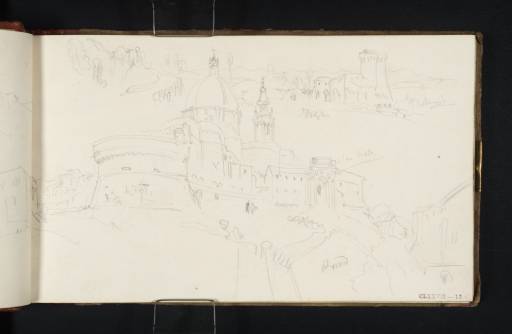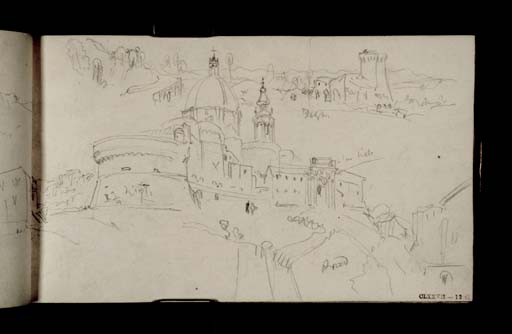Joseph Mallord William Turner The Santuario della Santa Casa, Loreto, from the Scala Santa; and a view of Villa Potenza 1819
Image 1 of 2
Joseph Mallord William Turner,
The Santuario della Santa Casa, Loreto, from the Scala Santa; and a view of Villa Potenza
1819
Joseph Mallord William Turner 1775–1851
Folio 12 Recto:
The Santuario della Santa Casa, Loreto, from the Scala Santa; and a view of Villa Potenza 1819
D14675
Turner Bequest CLXXVII 12
Turner Bequest CLXXVII 12
Pencil on white wove paper, 110 x 186 mm
Inscribed by the artist in pencil ‘R 3/4 high’ within sketch of round tower and ‘[?Y]’ within sketch of walls of the Santuario and ‘W’ to right of dome. Also ‘[...] high’ to right of gate and ‘Road’ bottom right of sketch and ‘[?Recina]’ underneath landscape sketch top right
Inscribed by John Ruskin in red ink ‘12’ bottom right
Stamped in black ‘CLXXVII 12’ bottom right
Inscribed by the artist in pencil ‘R 3/4 high’ within sketch of round tower and ‘[?Y]’ within sketch of walls of the Santuario and ‘W’ to right of dome. Also ‘[...] high’ to right of gate and ‘Road’ bottom right of sketch and ‘[?Recina]’ underneath landscape sketch top right
Inscribed by John Ruskin in red ink ‘12’ bottom right
Stamped in black ‘CLXXVII 12’ bottom right
Accepted by the nation as part of the Turner Bequest 1856
References
1909
A.J. Finberg, A Complete Inventory of the Drawings of the Turner Bequest, London 1909, vol.I, p.521 as ‘Chiesa della Casa Santa, Loreto’.
1974
Gerald Wilkinson, The Sketches of Turner, R.A. 1802–20: Genius of the Romantic, London 1974, reproduced p.18, as ‘Church of the Casa Santa, Loreto’.
1977
Gerald Wilkinson, Turner Sketches 1789–1820, London 1977, reproduced p.10, as ‘The Church of the Casa Santa, Loretto’.
1982
Evelyn Joll and Martin Butlin, L’opera completa di Turner 1793–1829, Classici dell’arte, Milan 1982, p.[120] under no.331.
1984
Martin Butlin and Evelyn Joll, The Paintings of J.M.W. Turner, revised ed., New Haven and London 1984, p.185 under no.331.
1984
Cecilia Powell, ‘Turner on Classic Ground: His Visits to Central and Southern Italy and Related Paintings and Drawings’, unpublished Ph.D thesis, Courtauld Institute of Art, University of London 1984, p.98, 408, 467 note 125, as ‘The Santuario della Santa Casa, Loreto, from the Scala Santa’.
1987
Cecilia Powell, Turner in the South: Rome, Naples, Florence, New Haven and London 1987, p.31 note 56.
The first significant place of interest on the route to Rome after Ancona was Loreto, a small city approximately fourteen miles to the south. In addition to offering impressive panoramic views of the surrounding countryside, Loreto was famous for its basilica, the Santuario della Santa Casa, a popular site for Catholic pilgrimage. Enshrined within the church is a small stone building, believed to be the Holy House, the home of the Virgin Mary where she received the annunciation and where Jesus spent his childhood. According to legend, the house was transported from Palestine during the thirteenth century by a host of angels and eventually carried to its present site where it came to rest amidst the laurel woods which give Loreto its name. Turner made a number of sketches in and around the city, see folio 10 (D14671).
This drawing shows the view from the Scala Santa looking towards the Santuario and the Porta Marina, the gate on the east side of the town which leads to the Piazzale Lotto and the back of the basilica. Built between 1469 and 1557 the style of the church, with its distinctive round apses topped by machicolated walls, combines ecclesiastical architecture with military-like fortifications. The white dome of the church, surmounted by an octagonal cupola, is the third largest in Italy. To the right of the dome can be seen the campanile or bell-tower, built by Luigi Vanvitelli in 1750–55, whilst in front of the church stands the circular bastion of the castellan walls. A small part of the sketch has spilled over onto the opposite sheet of the double-page spread, see folio 11 verso (D14674).
At the top of the page is a separate landscape sketch with a medieval tower. This may be the Torre del Mulino, a fortified flour mill, which can still be seen in the town of Villa Potenza, near the ancient Roman remains of Helvia Recina, approximately twelve miles south of Loreto, see folios 9 verso, 18 and 19 (D14670, D14687 and D14689). The road winding up the hill on the left leads to Macerata. Turner often used odd corners and spaces within his sketchbooks when he was in a hurry to capture passing landscapes from moving vehicles on the road.
Nicola Moorby
November 2008
How to cite
Nicola Moorby, ‘The Santuario della Santa Casa, Loreto, from the Scala Santa; and a view of Villa Potenza 1819 by Joseph Mallord William Turner’, catalogue entry, November 2008, in David Blayney Brown (ed.), J.M.W. Turner: Sketchbooks, Drawings and Watercolours, Tate Research Publication, December 2012, https://www


